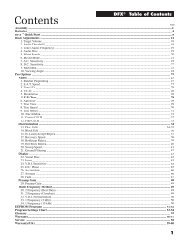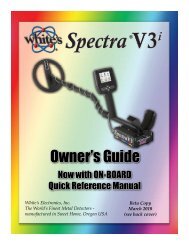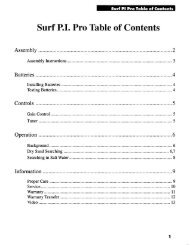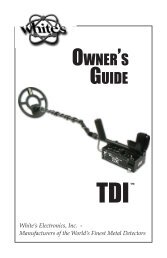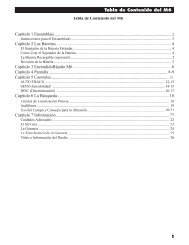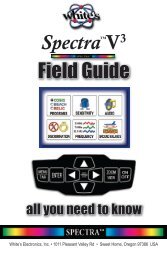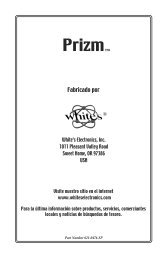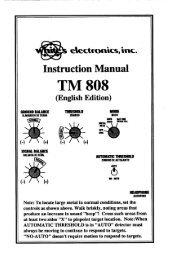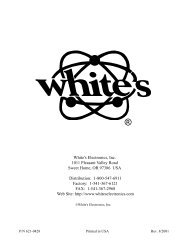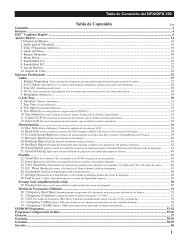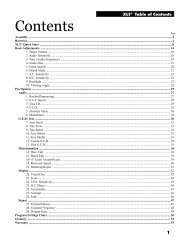Owners Guide - White's Metal Detectors
Owners Guide - White's Metal Detectors
Owners Guide - White's Metal Detectors
Create successful ePaper yourself
Turn your PDF publications into a flip-book with our unique Google optimized e-Paper software.
®<br />
Complete Owner’s <strong>Guide</strong> - Spectra 39<br />
• 2.5 kHz – Normalize – Different operating frequencies react to the same targets with different<br />
VDI numbers. Multi frequency software normalize target VDI scale.<br />
• Individual frequencies offer the choice of a natural VDI scale dictated by that frequency<br />
(Normalize OFF) or Normalize (shifting to the common scale).<br />
• Normalize avoids confusion providing the common VDI scale.<br />
• There are, however, advantages to using the naturally occurring VDI scales. At 2.5 kHz<br />
Normalize OFF significantly expands the VDI resolution at the high end of the scale (+90s)<br />
where 2.5 kHz is most effective (silver/copper range). The compromise is Normalize OFF<br />
at 2.5 kHz compresses VDI resolution at the low to mid range of the scale (nickel/gold range).<br />
Because the VDI calibration range is distorted with Normalize OFF, accept/reject VDI<br />
settings must be reevaluated.<br />
• If only high range targets are of interest, specific identification of unwanted targets within<br />
this high range is desired, and reconfiguring the accept / reject VDI numbers is implemented,<br />
discerning high range targets among high range unwanted targets can be enhanced with<br />
2.5 kHz and Normalize OFF.<br />
• 7.5 kHz - Normalize - 7.5 kHz provides reasonable traditional VDI calibration, little or no distortion to<br />
traditional VDI scale.<br />
• 22.5 kHz – Normalize – Normalize provides a traditional and common VDI scale.<br />
• There are, however, advantages to using the naturally occurring and different VDI scales<br />
for specific frequencies. At 22.5 kHz Normalize OFF expands the VDI resolution or<br />
range at the low to mid end of the scale (+20s) where 22.5 kHz is most effective (nickel/gold<br />
range). The compromise is Normalize OFF at 22.5 kHz compresses VDI resolution at the<br />
high range of the scale (copper/silver range). Because the VDI calibration range is distorted<br />
with Normalize OFF, accept / reject VDI settings must be reevaluated.<br />
• If only low to mid range targets are of interest (jewelry/nickels), specifc identification of<br />
unwanted targets within this mid range is desired (aluminum), and reconfiguring the accept /<br />
reject VDI numbers is implemented, discerning mid range targets among mid range trash<br />
(aluminum) can be enhanced with 22.5 kHz and Normalize OFF.<br />
Ground Tracking<br />
Autotrac “R” - Selects among options controlling the automatic ground rejection and ground mineral change<br />
tracking feature.<br />
• Ground Probe - From the LIVE CONTROLS, when Ground Tracking is highlighted,<br />
pressing ZOOM accesses the standard MENU with a Ground Probe on right side of display.<br />
Menu/Tab to Zero with search coil held in air away from all metals and ground minerals and<br />
press ENTER. At this point the search coil can be lowered to the ground, and measurements<br />
of significant ground data is displayed. Placing a target on or in the ground, and lowering the<br />
search coil, produces target plus ground data.<br />
• The Phase in a normalized VDI number format is displayed.<br />
• The phase angle in degree’s (360 degrees of phase) at each frequency in use, is displayed.<br />
• The signal strength (using a comparable Rx Gain of 8) in % at each frequency currently in<br />
use is displayed.<br />
• By noting and comparing these measurements to other ground and targets, or



